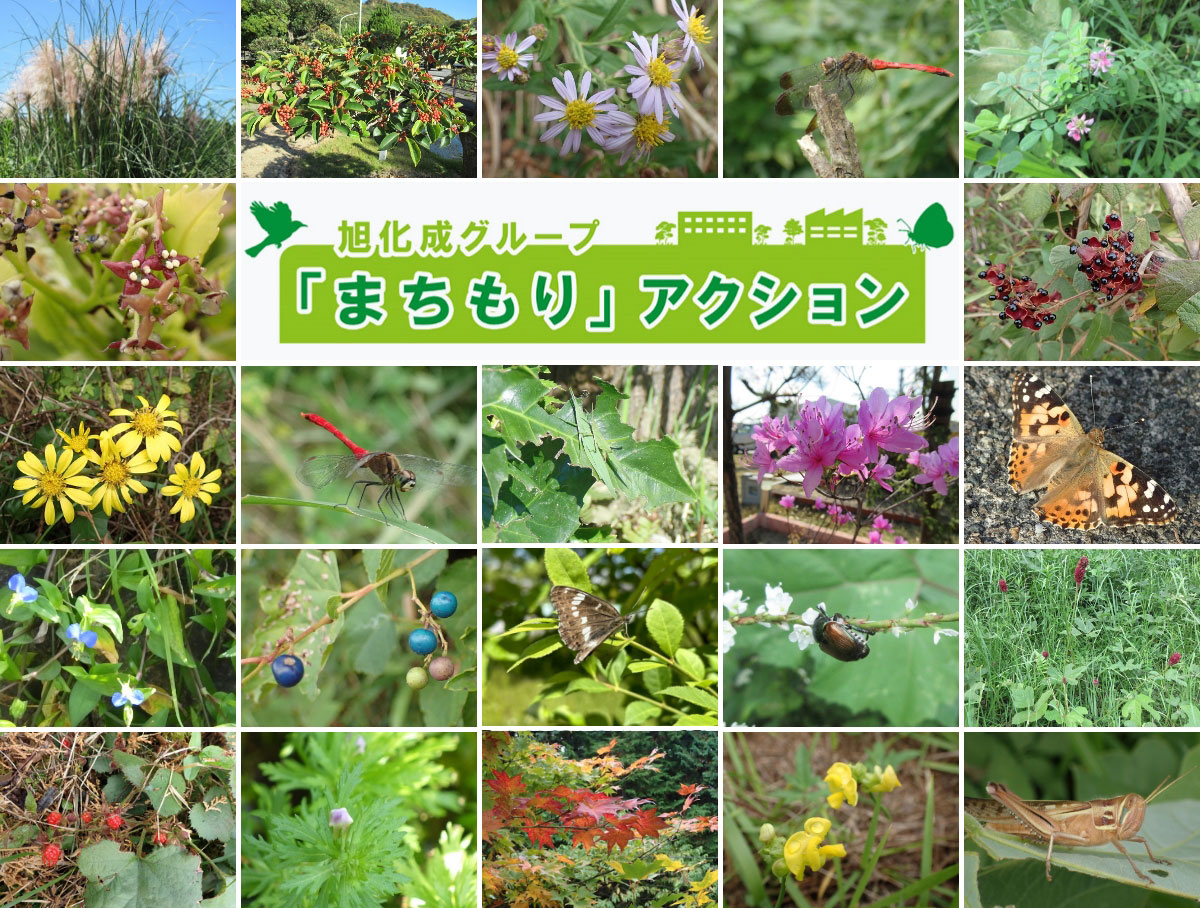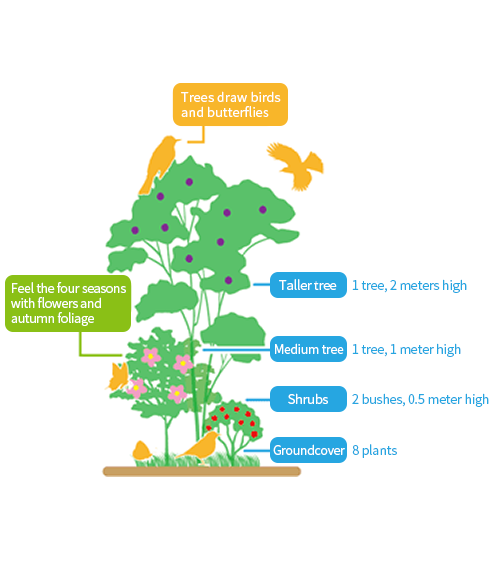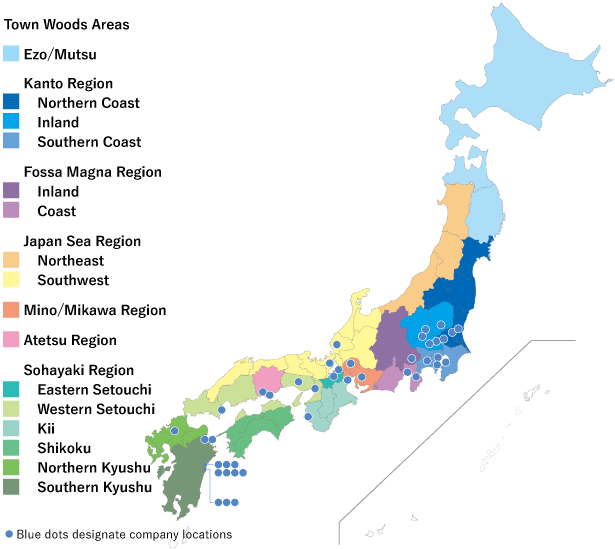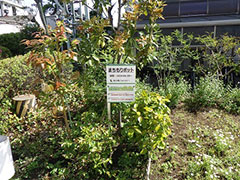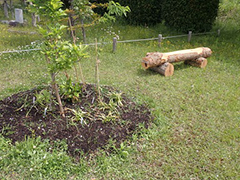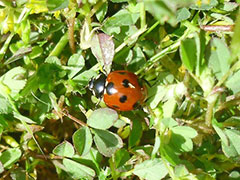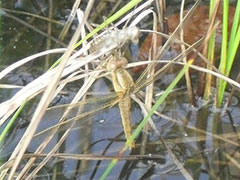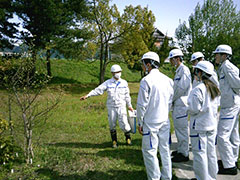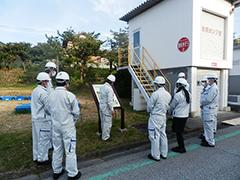Biodiversity
Policy
To ensure the sustainable utilization of living resources, the Asahi Kasei Group gives due consideration to reducing the impact of our business activities on biodiversity, and we have established guidelines for the preservation of biodiversity. Based on these guidelines, we have been working to understand the relationship between our business activities and biodiversity since 2010. In order to promote business activity mindful of biodiversity, we are working to raise awareness among personnel by various means including our ESH education program.
Assessment of nature-related risks and opportunities at Asahi Kasei Group production sites
The Asahi Kasei Group continues to make assessments in accordance with the LEAP approach, a method recommended by the TNFD* for evaluating nature-related risks and opportunities. So far, we have conducted a trial run to identify priority areas during the Locate phase.
We identified location information for major manufacturing sites in Japan and overseas, assessing them in accordance with the five "sensitive locations" as defined by the TNFD: areas important for conservation, areas of high ecosystem integrity; areas of rapid decline in ecosystem integrity; areas of high physical water risks, and areas of importance for ecosystem service provision. During the evaluation, we referred to TNFD's recommended tools such as IBAT, Resource Watch, and ENCORE.
In the future, based on the locations and priorities of each site identified in the "Locate" phase, we will evaluate the reliance and impact of our own business on nature in the "Evaluate" phase, assess the risks and opportunities related to nature in our own business in the "Assess" phase, and consider measures to deal with them in the "Prepare" phase.
- *Task Force on Nature-related Financial Disclosures, an international organization established in 2021 to build a framework for corporate risk management and disclosure regarding natural capital, etc.
Certification as a “site in harmony with nature”
Asahi Kasei has joined the 30by30 Biodiversity Alliance1 which was established by members of interested companies, local governments, and organizations in April 2022 in order to advance initiatives to gain OECM2 certification for areas safeguarded as company green spaces or under similar designations with the aim of achieving the 30by30 target. Asahi Woods of Life in Fuji City, Shizuoka Prefecture, was certified as a “Site in Harmony with Nature”3 in the first half of 2023.

- 1The 30by30 Alliance is an initiative to prevent and restore biodiversity losses while effectively preserving 30% or more of the Earth’s land and ocean area as healthy ecosystems by 2030.
- 2Other Effective area-based Conservation Measures is a designation for areas that contribute to conservation of biodiversity outside of protected areas.
- 3Site in Harmony with Nature is a system launched in 2023 by the Ministry of the Environment of Japan to certify areas where biodiversity is conserved with the support of local communities, etc., with 122 sites including the Asahi Woods of Life certified in 35 prefectures around Japan in the first year. Moving forward, certified sites other than those also designated as protected areas are planned to be registered in a global database.
Investigation of impact on biodiversity by procurement
Regarding the impact of our business activities on biodiversity when there is a newly used raw material or a change in use of raw materials, we use a survey sheet on the relationship between business operations and biodiversity to examine the country of origin of raw materials, processers and manufacturers, and primary vendors (trading companies, etc.), in order to confirm the absence of any problem.
Group-wide activities for biodiversity
What is the "Town Woods" Program?
We aim to increase value from the perspective of biodiversity while enhancing green spaces at Asahi Kasei Group operating sites in Japan. We will use Town Woods Pots as a tool to heighten understanding and awareness of the value of biodiversity among personnel.
What are Town Woods Pots?
This new way of landscaping by Asahi Kasei Homes combines four layers of vegetation of varying heights: Tall, medium, short, and groundcover. While compact enough to integrate with urban residential areas, they increase the space for other plants and wildlife in artificial environments that otherwise have little greenery. Our Town Woods Program uses the phytosociological method to classify green spaces at operating sites throughout Japan, selecting the most suitable regional vegetation when creating the Town Woods plantings.
Town Woods Project: FY2019–2022 Results
- Town Woods Points (Machi-Mori Point: MMP) Initiatives at the Group sites are divided into four stages. Each initiative earns Town Woods Points and the points are aggregated across the group.
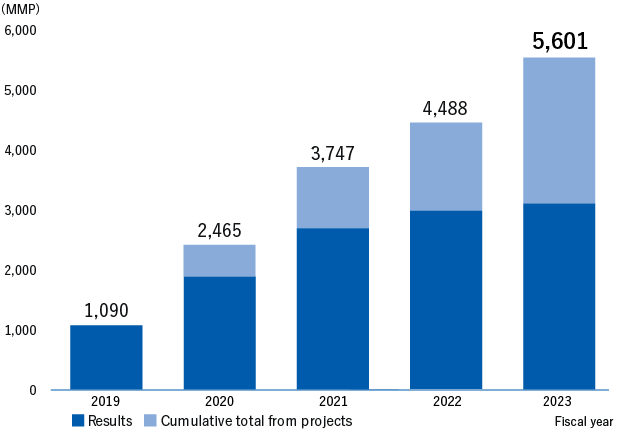 Cumulative Total of Town Woods Points
Cumulative Total of Town Woods Points
| Stage | Example Initiatives |
|---|---|
| Stage 1: Installation |
|
| Stage 2: Observation |
|
| Stage 3: Dissemination |
|
| Stage 4: Development Initiatives in other locations |
|
FY2022 Project: "Town Woods" Nuts and Seeds Watching
In fiscal 2022, we held a limited time project for employees to think about the diversity of plants and the connection between plants and animals by observing the nuts and seeds of trees. The project provided an opportunity for employees to get closer to nearby nature such as green spaces inside the office, areas around our Town Woods Pots, home gardens, neighborhood parks and on the roadside. We split the project into two periods, from September 1 to October 15, and from October 16 to November 30, during which participants submitted their predictions on how the nuts and seeds get transported out of seven different dispersal methods.
The project received 145 submissions (444 MMP) on 98 species of nuts and seeds in 61 families with the most common method of dispersal found to be by animals. Experts explained that among the types of animal dispersal, the common form whereby an animal eats the nut or berry and the tree or plant thereby has its seeds carried away, is beneficial both for the animal and the tree. But the method whereby the seed attaches to the animal’s fur or bird’s wing, for example, has no benefit for the animal and so animal dispersal can always be seen to favor the tree or plant.
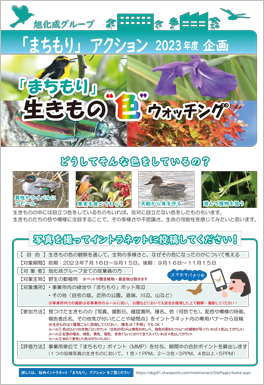
Notable activities in fiscal 2022
Actions in the Moriyama Area
Ex-situ conservation of smallhead stickleback, an endangered freshwater fish, and joint effort among companies and communities for dragonfly conservation
In Moriyama, we draw groundwater for industrial use in cooling equipment. Its quality is strictly monitored, and it is discharged to nearby rivers after use. A portion of the discharged water from our Moriyama Works is also used for agriculture, which has become vital for local farmers as well as wildlife inhabiting the waterfront areas.
Against this backdrop, and since water is intrinsically related to our business operations, in fiscal 2010 we started initiatives to protect biodiversity with a focus on water resources.
In fiscal 2015, we began ex-situ conservation of smallhead stickleback, an endangered freshwater fish, and in fiscal 2016, we began dragonfly conservation activities in cooperation with companies that have operations located in Shiga Prefecture and local communities. In fiscal 2022, we held an observation session at the “Moribio” biotope for employees and their families for the first time in four years. At the observation event, as participants received explanations and support from experts, they were given an opportunity to learn about biodiversity conservation while they enjoyed catching and observing smallhead stickleback that live in ponds and waterways, and dragonflies that have emerged and marked themselves in the Moribio.
In conjunction with a suspension of operation for maintenance at the Moriyama Works, we drained the conservation pond and carried out a survey on the habitat of the smallhead stickleback, confirming that over 800 individual fish inhabit the biotope. Due to the suspension of operation, the supply of groundwater necessary for the smallhead stickleback's habitat was also halted, so the fish were returned back to their original home in the Kanegamori Residents’ Association Conservation Pond. After draining the pond, we once again released 60 smallhead stickleback into the Moribio pond where we continue our conservation activities and monitor their breeding.
In collaboration with companies that have operations located in Shiga Prefecture, we are involved in "Operation Dragonfly 100: Save Shiga's Dragonflies!" (sponsored by Biodiversity Biwako Network). This project involves working with local communities to survey the habitat of the Sympetrum kunckeli variety of dragonfly, which resides in wetlands, and to conserve it using a container biotope.
In fiscal 2022, we were able to confirm the spawning, nymph, emergence, and adult stages of the dragonfly. This is proof that the dragonfly that emerged in the container biotope last year have now settled in the Moribio.
A further 15 species of dragonflies from 6 other families have also been found in the Moribio, including the Anaciaeschna martini, a species for which there is little information in Moriyama City, making it clear that the Moribio is an essential place for local biodiversity.
We will continue to work on biodiversity activities through conservation at the Moribio.
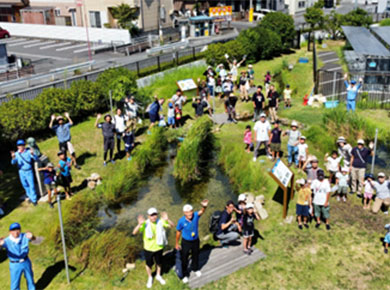 Observing wildlife at the Moribio
Observing wildlife at the Moribio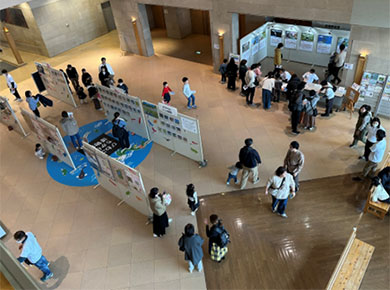 Smallhead stickleback being returned back to the Kanegamori Residents’ Association Conservation Pond
Smallhead stickleback being returned back to the Kanegamori Residents’ Association Conservation Pond
Actions by Asahi Kasei Juko Co., Ltd.
Project to rediscover living with the woods and water in Higashiomi
We are carrying out conservation works at Asahi Kasei Jyuko Co., Ltd.’s Shiga Plant—principally at the “Yuya Hebel Biotope” created on the plant’s grounds in June 2017—in aid of the four-spotted skimmer (our “nominated dragonfly”), a keystone species on the Shiga red list and which surveys of dragonflies in the surrounding area show to be at risk of extinction due to habitat degradation in recent years.
In the five years up to May 2021, we have seen that the four-spotted skimmer that have emerged in the “Yuya Hebel Biotope” or that have flown in from outside have been breeding, confirming that they have basically become an established species in the biotope.
In fiscal 2022, we replanted evergreen trees, mainly deciduous trees, from among the seedlings around the biotope in June, and in November, we replanted them in pots, with the aim of establishing a planting system that makes it easy for the four-spotted skimmers that have emerged in the biotope to remain there for a given period.
We plan to grow the seedlings in pots over the next two to three years, and then replant them around the biotope.
 A four-spotted skimmer dragonfly that emerged in the biotope
A four-spotted skimmer dragonfly that emerged in the biotope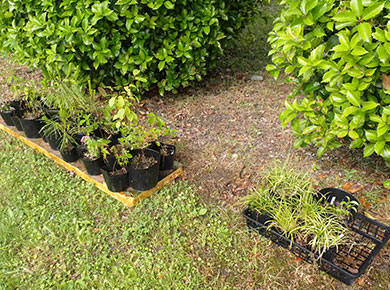 Growing deciduous tree seedlings in pots
Growing deciduous tree seedlings in pots
Actions in the Suzuka Area
A river known as River No. 19 cuts through the grounds of our Suzuka Works from north to south, and water used in the production line is discharged into this river with strict water-quality monitoring in place. Although the river is narrow, it supports much aquatic life that finds it easy to live there, protected by the old stone embankment. In and around the gaps between the stones on the embankment, you can see plants such as dwarf ambulia growing, crabs thriving, and fish such as the fresh-water sprat and Amur catfish coming and going. On the waterside also, dragonflies, and occasionally birds such as ducks, herons, and egrets, come to take a rest. Previously, many employees have witnessed the soft-shelled turtle mating, and more recently, a baby soft-shelled turtle was found when weeding the area, and we were able to confirm that the parents and baby were living together. Employees look forward to seeing what kind of creatures they may find when walking by the river. In order to maintain the waterside environment of River No. 19, which is home to many aquatic creatures, it is important to ensure the quality of the discharged water is monitored properly. Going forward, we will continue to work to protect the environment so that these aquatic organisms can live safely by not only conducting water quality monitoring in all production departments but also monitoring water quality near the gates where effluence is combined and discharged into the river, and by maintaining the stone embankments.
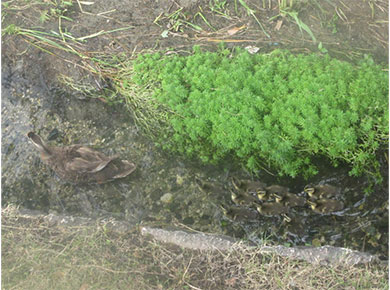 A couple of ducks spotted recently (on the left is the stone embankment of River No. 19)
A couple of ducks spotted recently (on the left is the stone embankment of River No. 19)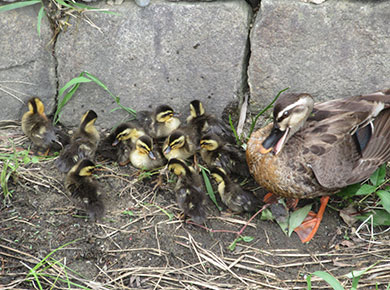 Left: The baby turtle that was found (left of the tape measure), Right: The turtle released into the river
Left: The baby turtle that was found (left of the tape measure), Right: The turtle released into the river
Actions in Nobeoka and the Hyuga Area
Since 2007 we have participated in a reforestation program led by Miyazaki prefecture to create forests in cooperation with companies. We planted more than 47 hectares of broad-leaf trees and other trees native to the area, replacing plantations of cedar and cypress. This included 23 hectares in Hinokagecho, 20 hectares in Takachiho, 1 hectare in Gokase, and 3 hectares in Kitakatacho.
In the past, as many as 400 people took part in these tree-planting activities, but because of the pandemic they were put on hold for a while. However, activities were resumed in fiscal 2022 with the number of participants limited to approximately 150 people. In fiscal 2023, approximately 120 people took part and planted 1,500 trees on 1 hectare of land.
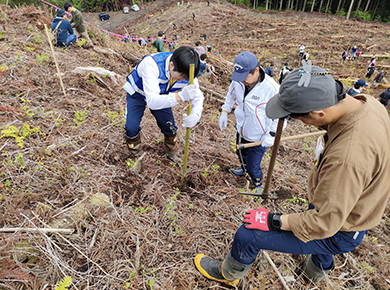 Planting trees
Planting trees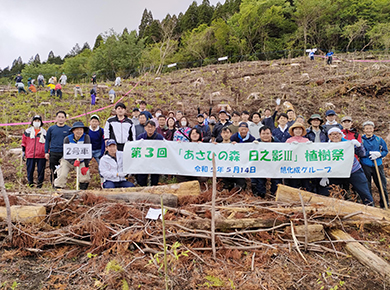 Commemorative photo after tree planting session
Commemorative photo after tree planting session
Please refer to the document below to see Asahi Kasei Homes initiatives.


